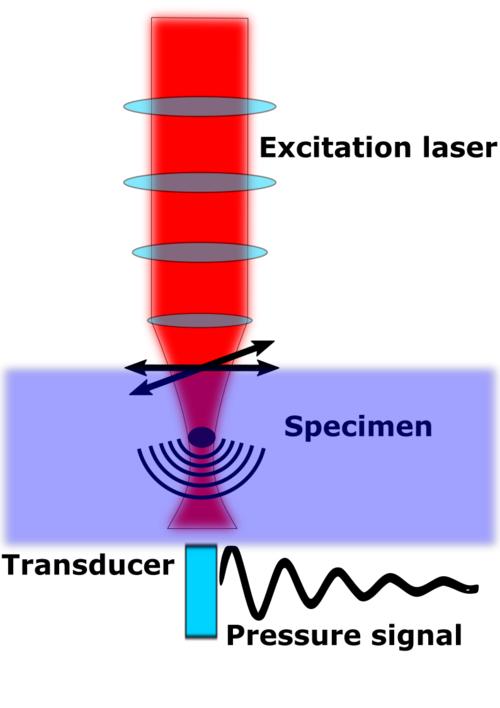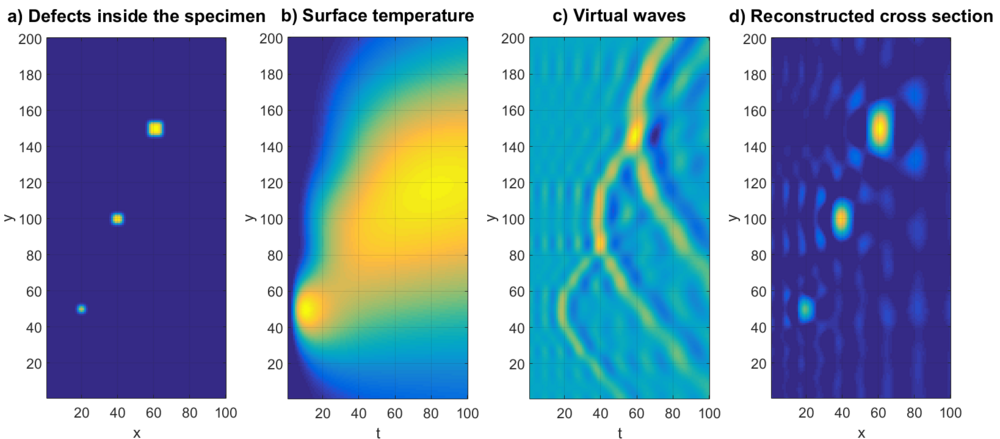Project description
Analysis of structural imperfections of materials, spare parts, or components of a system is very important in order to prevent malfunctioning devices. For economic reasons, these investigations should be carried out in a non-destructive way. For instance, ultrasonic testing is a widely used technique, which is based on ultrasound wave propagation in the specimen to be tested. In this case, ultrasound waves pass through the material and are reflected by the defects. The echo pulses can be measured on the surface of the specimen, which are used to localize the defects in question. The research project focuses on photoacoustic and thermographic imaging, in which multiple 1D surface measurements are combined to reconstruct the original pressure or heat distribution in the cross section of the sample. Medical imaging is another possible application, where abnormalities of the biological tissue should be detected.
Photoacoustic imaging, also called optoacoustic or thermoacoustic imaging, is based on the generation of ultrasound following a temperature rise after illumination of light absorbing structures with-in a (semi)transparent and turbid material, such as a biological tissue. It provides optical images with specific absorption contrast. In photoacoustic tomography the temporal evolution of the acoustic pressure field is sampled using an array of ultrasound detectors placed on or outside the tissue surface or by moving a single detector across the detection surface. Images of the optical absorption within the tissue are then reconstructed by solving an inverse source problem. The main goal of this research is to improve the reconstruction accuracy by using state space models and optimization of the excitation laser signals. In order to deal with the ill-posedness of the problem, regularization methods can be applied incorporating additional conditions such as non-negativity and sparsity.
Project Facts
ISP Research Team
Péter Kovács
Michael Lunglmayr
Christian Motz
Oliver Lang
Mario Huemer
Funding
RECENDT, opens an external URL in a new window GmbH
JR Center, opens an external URL in a new window for Thermal NDE of Composites
Partners
RECENDT, opens an external URL in a new window GmbH
JR Center, opens an external URL in a new window for Thermal NDE of Composites
Duration
May 2018 - Dec. 2018
In case of thermographic imaging the specimen is heated, then the corresponding temperature evolution is measured on the sample surface. Compared to ultrasonic testing, the physical phenomena for thermography is quite different, which is described by the heat diffusion equation. However, the original problem can be reformulated in such a way that ultrasound imaging techniques are applicable. The figure below demonstrates each step of this transformation, which is again an ill-posed inverse problem causing artifacts in the reconstructed image, see, for example, figure d). In this project, we are focusing on regularization techniques in order to improve the reconstruction accuracy.


Publications
2) Lang O., Kovács P., Motz C., Huemer M., Berer T., Burgholzer P., "A linear state space model for photoacoustic imaging in an acoustic attenuating media," in Inverse Problems, Vol. 35, Nr. 1, IOP Publishing, 2019
1) Burgholzer P., Motz C., Lang O., Berer T., Huemer M., "Chirped or time modulated excitation compared to short pulses for photoacoustic imaging in acoustic attenuating media" in Proceedings SPIE 10494, Photons Plus Ultrasound: Imaging and Sensing 2018, 2018